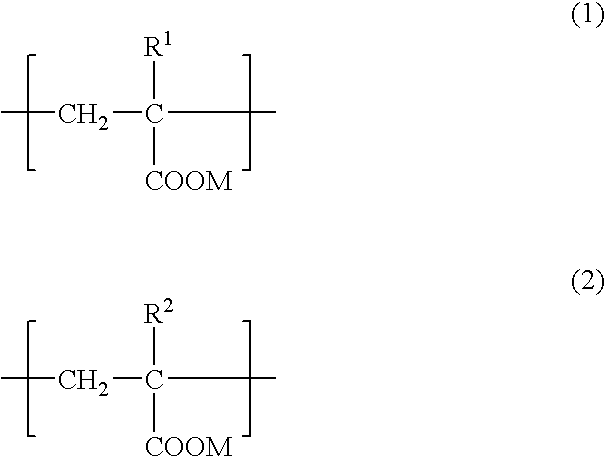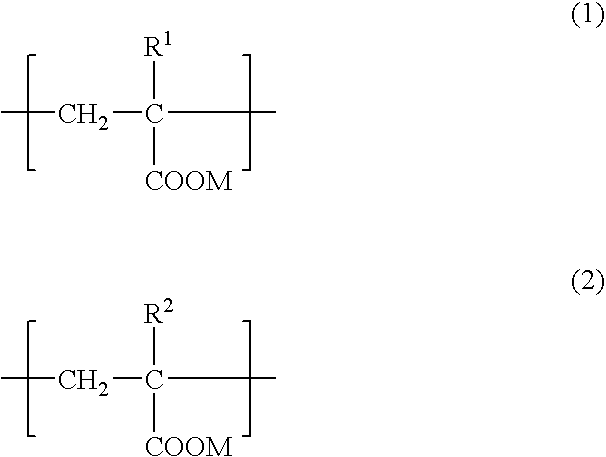Adhesive composition for dermal patch and production process thereof
a technology of adhesive composition and dermal patch, which is applied in the direction of adhesive types, anti-inflammatory agents, drug compositions, etc., can solve the problems of acryl-base polymer still having a problem of toxicity, strong skin irritation, and reduced absorption of medicaments, so as to achieve no generation, good adhesion to the adherend, and less skin irritation
- Summary
- Abstract
- Description
- Claims
- Application Information
AI Technical Summary
Benefits of technology
Problems solved by technology
Method used
Image
Examples
example 1
[0111]
Blended components and blending ratioSodium polyacrylate2parts(viscosity* 560 mPa · s)Glycerin75.9partsAluminum sulfate1partmagnesium hydroxide-aluminum hydroxide0.5partsco-precipitateWater18.975partsSodium hydroxide0.625partsCarboxyvinyl polymer1part
*The viscosity in 0.2 mass % aqueous solution in all the Examples was measured using B-type viscosity meter (measuring condition: 20° C., Rotor No. 2, 30 rpm, 30 minutes)
Formulation
[0112] A dispersion of sodium polyacrylate (“Viscomate F480SS” produced by Showa Denko K.K.) (2 parts) and glycerin (10 parts) was added and mixed to a mixed solution of water (12.5 parts) and aluminum sulfate (1 part). When the polymer was started to dissolve and the solution was thickened, a mixed solution of glycerin (65.9 parts), carboxyvinyl polymer (“AQUPEC HV-504E” produced by Sumitomo Seika Chemicals Co., Ltd.) (1 part) and magnesium hydroxide-aluminum hydroxide co-precipitate (“Sanalmin” produced by Kyowa Chemical Industry Co., Ltd.) (0.5 pa...
example 2
[0114]
Blended components and blending ratioAcrylic acid / sodium acrylate5.5parts(10 / 90 (by mol)) copolymer(viscosity 401 mPa · s)Glycerin75.86partsCapsaicin0.5partsAluminum sulfate1.6partsPurified water14.54partsN-vinylacetamide / sodium acrylate2parts(90 / 10 (by mass)) copolymer
Formulation
[0115] A mixed solution of acrylic acid / sodium acrylate copolymer (5.5 parts), glycerin (12.94 parts), capsaicin (0.5 Parts) and N-vinylacetamide / sodium acrylate copolymer (2 parts) was gradually added to a mixed solution of aluminum sulfate (1. 6 parts) and purified water (14.54 parts). When the solution became uniform, glycerin (62.92 parts) was gradually added and kneaded until the system became uniform.
[0116] The obtained sol was shaped, sealed, aged at about 20° C. for 3 days and then taken out from the container. When the resulting gel was touched with a finger, elongation and strong resilience were exhibited.
example 3
[0117]
Blended components and blending ratioSodium polyacrylate4parts(viscosity 675 mPa · s)Glycerin57.9partsPropylene glycol15partsAluminum sulfate1partPurified water18.6partsCarboxyvinyl polymer2partsDiclofenac sodium1partmagnesium hydroxide-aluminum hydroxide0.5partsco-precipitate
Formulation
[0118] Sodium polyacrylate (4 parts) and glycerin (13.6 parts) were added to a mixed solution of aluminum sulfate (1 part) and purified water (18.6 parts) and kneaded until the system became uniform. Subsequently, a mixed solution of glycerin (44.3 parts), propylene glycol (15 parts), carboxyvinyl polymer (“CARBOPOL 934” produced by Noveon Inc.) (2 parts) and magnesium hydroxide-aluminum hydroxide co-precipitate (“Sanalmin” produced by Kyowa Chemical Industry Co., Ltd.) (0.5 parts) was gradually added and diclofenac sodium (1 part) was further added and kneaded.
[0119] The obtained sol was shaped, sealed, aged at about 20° C. for 3 days and then taken out from the container. When the resultin...
PUM
| Property | Measurement | Unit |
|---|---|---|
| Percent by mass | aaaaa | aaaaa |
| Percent by mass | aaaaa | aaaaa |
| Percent by mass | aaaaa | aaaaa |
Abstract
Description
Claims
Application Information
 Login to View More
Login to View More - R&D
- Intellectual Property
- Life Sciences
- Materials
- Tech Scout
- Unparalleled Data Quality
- Higher Quality Content
- 60% Fewer Hallucinations
Browse by: Latest US Patents, China's latest patents, Technical Efficacy Thesaurus, Application Domain, Technology Topic, Popular Technical Reports.
© 2025 PatSnap. All rights reserved.Legal|Privacy policy|Modern Slavery Act Transparency Statement|Sitemap|About US| Contact US: help@patsnap.com



